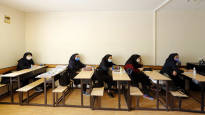Iranian authorities consider it possible that the young women were poisoned, possibly in retaliation for their participation in Iran’s widespread protests.
Hundreds of young Iranian women have been hospitalized due to suspected poisoning in recent months.
The latest cases of poisoning were recently reported in the cities of Quom and Pardis in Tehran province.
On Tuesday, in the city of Pardis, at least 35 students of a girls’ school had to be hospitalized due to breathing problems.
In addition, students from schools located in Borujerdin were again rushed to the hospital on Sunday due to symptoms of poisoning.
In the province of Lorestan, at least 194 girls from four schools have had to be hospitalized due to poisoning symptoms during the past week.
BBC’s (switching to another service) according to at least 650 girls have been poisoned since November.
British of Guardian (you switch to another service) organophosphates have probably been used in the poisonings. The poison can cause nausea, dizziness and fatigue.
Deputy Minister of Education Younes Panahin the substance used in the poisoning of the girls is freely available, the local Tasnim news agency reported on Sunday.
According to Panah, no one has been arrested.
Who wants girls out of schools?
Poisonings have been reported, for example, in the city of Qom, where important Shia Muslim shrines are located.
Local authorities believe that the attacks are an attempt to force girls out of schools.
Activists have compared attacks on Iranian schools to terrorism against women by the Afghan Taliban and Nigeria’s Boko Haram.
Both extremist organizations oppose girls’ education.
Several girls have missed school due to poisoning cases.
According to the Guardian, a teacher working in Qom in the province of Tehran told radio channel Farda that only 50 of the 250 students are currently attending classes.
In addition, several schools have been closed due to the investigation.
The woman’s death spurred the scarf protests
The British newspaper Guardian, on the other hand, says that the Iranian authorities confirmed that they were investigating whether schoolgirls could be poisoned as revenge for participating in protests against the headscarf requirement.
For example, in October, female students at several educational institutions took off their headscarves to protest Amin’s death.
Last September, widespread protests broke out in the country when the 22-year-old Mahsa Amini died at the hands of the chastity police. It is said that Amin was initially targeted by the chastity police because of a scarf he was wearing incorrectly.
In protest against the authorities’ violence, thousands of women defied the headscarf requirement and cut their hair in the streets.
